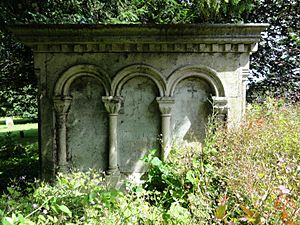George Witt (collector) facts for kids
Quick facts for kids
George Witt
|
|
|---|---|
| Born | 25 March 1804 Swaffham Prior, Cambridgeshire, England
|
| Died | 20 February 1869 (aged 64) London, England
|
| Nationality | British |
| Education | Leiden University |
| Spouse(s) | Elizabeth Hedley |
George Witt (born March 25, 1804 – died February 20, 1869) was a British doctor, banker, and mayor. He was also a Fellow of the Royal Society (FRS), which means he was recognized for his important contributions to science. Witt was well-known for his large and unique collections of historical and cultural items.
A Young Doctor's Life
George Witt was born in Swaffham Prior, a small village in Cambridgeshire, England. He was the fifth son of Matthew Witt, a farmer, and Sarah Woollard. He was baptized at St. Mary's Church in Swaffham Prior in 1805.
Witt decided to become a doctor. He studied at Northampton General Infirmary. After his training, he worked for a short time with the East India Company. This was a powerful British trading company. During this time, he bravely managed a serious cholera outbreak on a ship in Calcutta (now Kolkata), India.
His important work in Calcutta helped him earn a Doctor of Medicine degree from Leiden University in the Netherlands. He only spent three months visiting Leiden, but his practical experience was highly valued.
In 1832, George Witt married Elizabeth Hedley in Bedford. He started his medical practice in Bedford. He quickly became a respected doctor. He rose to lead the medical team at Bedford Infirmary. By 1834, he was elected Mayor of Bedford. In the same year, he also became a Fellow of the Royal Society. This was a big honor for his scientific work.
Witt tried to become an Alderman (a senior member of the town council) in Bedford. However, his first attempt in 1835 failed. Some people thought he hadn't been a top-notch mayor. He finally became an Alderman in 1845.
In 1849, Witt left the Infirmary for personal reasons. He was given the title "physician extraordinary" to honor his contributions. Witt was known for donating medical specimens. His collections of old artifacts and natural history items were also very valuable. People even thought about starting a museum in Bedford using his collection. Some of his collection was later sold and became part of the Bedford Modern School and eventually the Bedford Museum.
Adventures in Australia and London
In 1850, George Witt moved to Australia and settled in Sydney. He continued his medical career there for a short time. However, he soon became interested in banking and investing. He was very successful and made a large fortune as a banker.
Witt then returned to the United Kingdom. He used his wealth to build a new home near Hyde Park in London. Here, he began to build a new collection of unique and sometimes controversial items. Witt was interested in both ancient and modern pieces. He didn't always focus on where the objects came from. He shared his collection with other collectors around the world who also appreciated these special artifacts.
In 1865, after an illness, Witt offered his collection to the British Museum. The museum's director, Anthony Panizzi, agreed to take the items. Witt's collection became a significant part of a special, private collection at the museum. This collection was known as the museum's Secretum. Panizzi believed the collection was important enough for the museum.
Witt's collection included items from many ancient civilizations. These included objects from Greece, Rome, Egypt, India, China, Tibet, Japan, and Native American cultures. Besides votive objects (items offered to gods), he collected bronzes and pottery. His collection also featured watercolors and sketches. He had a notable library and records of his letters. These letters included details about items not in his collection, like a list from the secret cabinet of Naples Museum.
George Witt passed away on February 20, 1869, at his home in London. He was buried in Swaffham Prior. His wife, Elizabeth, also died at the same house in 1871 and was buried beside him.
Witt's Lasting Impact
Witt's collection remained together in the British Museum's Secretum until the Second World War. In 1939, some items were removed from the collection. These were then organized based on where they came from.
An interesting story shows how carefully the museum guarded the collection. Once, a researcher asked to see the list of items. The museum curators were very cautious. They wanted to know why the researcher needed the list and what they planned to do with it. They even asked what arrangements would be made for the list after the researcher's death!
As of 2014, about half of Witt's original collection is still kept in the "secret" collection. These items have not been reclassified. Museum curators believe these remaining items, along with about 100 others from different sources, should stay together. They see them as important records of Victorian-era values and how ideas about what was considered "controversial" changed over time.


